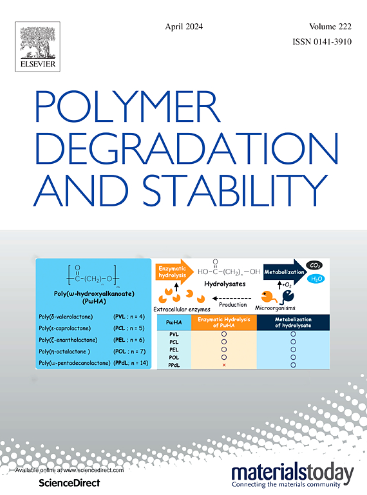Molecular dynamics and finite element analysis of partial discharge mechanisms in polyimide under high-frequency electric stress
IF 6.3
2区 化学
Q1 POLYMER SCIENCE
引用次数: 0
Abstract
High-frequency power transformers (HFPTs) are critical components of solid-state transformers (SSTs), enabling voltage conversion and electrical isolation in advanced power distribution systems. However, the insulation systems of HFPTs face significant challenges due to high-frequency electrical stress and partial discharges (PD). This study investigates the failure mechanisms of polyimide (PI) insulation under high-frequency electrothermal stress through a combination of experimental analysis and numerical simulations. A high-frequency partial discharge test platform was utilized to evaluate PD behavior in PI films under sinusoidal voltages at various frequencies. Experimental results revealed that increasing frequency reduced the insulation breakdown time and discharge counts while intensifying discharge amplitude and accelerating material degradation. Fourier Transform Infrared Spectroscopy (FTIR) confirmed the successful synthesis of PI films and demonstrated a reduction in key chemical bonds following degradation. ReaxFF molecular dynamics simulations provided insights into the degradation mechanisms, identifying CO as the most abundant degradation product, followed by H₂, H₂O, CN, and acetylene (C₂H₂). Finite element simulations, based on a one-dimensional non-equilibrium plasma model, elucidated the spatiotemporal evolution of electric fields, electron density, electron temperature, space charge, and PD currents. The results demonstrated a direct correlation between higher frequencies and intensified PD activity, including stronger electric fields and increased electron energy. This comprehensive study bridges experimental observations with simulation results, advancing the understanding of insulation failure mechanisms in HFPTs under high-frequency stress.
求助全文
约1分钟内获得全文
求助全文
来源期刊

Polymer Degradation and Stability
化学-高分子科学
CiteScore
10.10
自引率
10.20%
发文量
325
审稿时长
23 days
期刊介绍:
Polymer Degradation and Stability deals with the degradation reactions and their control which are a major preoccupation of practitioners of the many and diverse aspects of modern polymer technology.
Deteriorative reactions occur during processing, when polymers are subjected to heat, oxygen and mechanical stress, and during the useful life of the materials when oxygen and sunlight are the most important degradative agencies. In more specialised applications, degradation may be induced by high energy radiation, ozone, atmospheric pollutants, mechanical stress, biological action, hydrolysis and many other influences. The mechanisms of these reactions and stabilisation processes must be understood if the technology and application of polymers are to continue to advance. The reporting of investigations of this kind is therefore a major function of this journal.
However there are also new developments in polymer technology in which degradation processes find positive applications. For example, photodegradable plastics are now available, the recycling of polymeric products will become increasingly important, degradation and combustion studies are involved in the definition of the fire hazards which are associated with polymeric materials and the microelectronics industry is vitally dependent upon polymer degradation in the manufacture of its circuitry. Polymer properties may also be improved by processes like curing and grafting, the chemistry of which can be closely related to that which causes physical deterioration in other circumstances.
 求助内容:
求助内容: 应助结果提醒方式:
应助结果提醒方式:


